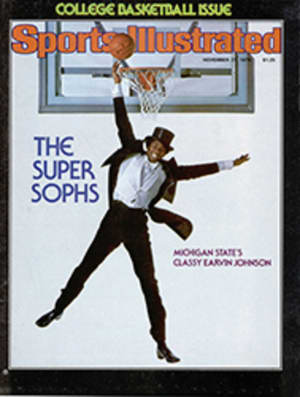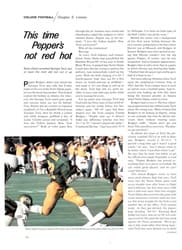
THE BEST WOMAN MAY BE A MERE GIRL
The race for the women's national title, now held by UCLA, promises to be a wide-open shoot-out, with any one of 10 teams capable of taking the championship. The outcome may well hinge on the answer to this year's big question: Who is going to replace last season's best seniors, Ann Meyers of UCLA, the first four-time women's All-America, and Montclair State's Carol (Blaze) Blazejowski, the nation's leading scorer with a 38.6 average? They led their teams to the final four of the AIAW tournament, and their meeting there, though it occurred in the semifinals, was the title game in all but name.
The players most likely to take their teams to the finals at Greensboro, N.C. would seem to be Old Dominion junior Nancy Lieberman, Tennessee senior Cindy Brogdon and North Carolina State junior Genia Beasley. But upperclassmen have no lock on the starring roles, because they will be pressed by the best and largest contingent of sophomores ever to play the women's game. "Each year the kids coming in are bigger, better, faster and more numerous," says UCLA Coach Billie Moore. "Four or five years ago I would have had difficulty naming five great players. Now there are 12 in the sophomore class alone."
Heading the list is the Bruins' Denise Curry, a 6'1" forward. In her first college game, Curry led the UCLA scorers with 27 points and its rebounders with 15 in an 84-70 victory over San Jose State. Twelve days later she set a school single-game scoring record of 30 points, and by the end of the season she had four more UCLA records, three of which had been held by the redoubtable Meyers: most points in one season (610); best field-goal percentage (62.1%, third highest in the nation); best scoring average (20.3 points); and most rebounds in a game (25). "Denise amazes me," says Moore. "She has a fluid, natural style that makes everything look easy, and she's so consistent that I can't name her best game. Even though she's a forward, her ball handling is so good that she often brings the ball up for us, and she's one of the best pure shooters around. She has a tremendous first step, great mobility and upper-body control."
That is high praise for a 19-year-old, but Moore's coaching rivals agree with her assessment. Stephen F. Austin's Sue Gunter, who coached Curry on the U.S. team that took the silver medal in Bulgaria last summer, says, "Eve never seen a second-year kid do so much so well. She's an outstanding shooter from inside or from 20 feet, and she can handle the ball like a guard. She's just phenomenal."
The soft-spoken phenomenon from Davis, Calif. began absorbing and perfecting the finer points of basketball when she was five years old. Curry's first teachers were her father Les, who is a high school coach, and her older brother Mike, a starting guard for Montana's Rocky Mountain College. Curry attended all her dad's home games, and Mike always encouraged her to play in the pickup games on the family court. By watching and competing against boys, Curry developed the rugged inside moves that now mark her game. Her shooting touch came easier, perhaps because she is a natural—she was Davis High MVP in hoops, volleyball and Softball—but she polished it at summer camps and in one of the best girls' basketball programs in California.
In her three seasons at Davis, Curry averaged 24.9 points and grabbed 14.2 rebounds a game. Her team lost only five of 75 games and won two San Joaquin Section titles, and she was voted California Player of the Year in 1977. She also was the first athlete at Davis—male or female—to have a jersey retired. After more than 30 colleges offered her scholarships, Curry decided on UCLA because of its strong women's program and its high academic standing.
Curry, whose teammates call her Casper because of her pale complexion, may be the best of the sophomores, but she is merely typical of them when it comes to explaining how she became so good. In fact, her words have an ageless quality; these sentiments might have been expressed by 19-year-old men as far back as 30 or 40 years ago. Now those feelings are those of a generation of young women.
"I've wanted to be a basketball player since I can remember," Curry says. "My dad never pushed me, but he was always there if I needed advice. Basketball was always something to look forward to.
"In my sophomore year in high school I was 5'10", and I thought I might have the potential to earn a scholarship. Since then basketball has been my focal point, my life. I played other sports, but my free hours were spent shooting.
"Offensively my game is sound, but I'm weak on defense. In high school you don't learn defense, so I need to work at being aggressive. I'm not interested in records. I'm shooting to make the trip to Moscow in 1980, but first I want to see us get back to the nationals."
The Bruin schedule includes 16 of the Top 20 teams; for them to return, Moore will again have to look to a freshman—this time she is Melanie Horn—to round out her squad. Horn, a 6'5" center, needs to be more aggressive, but Moore is known for developing centers, and she should have Horn raring to go by tournament time. Teaming with Curry and senior playmaker Anita (Juice) Ortega, who has the moves of her namesake, Horn could help bring another championship to UCLA.
As good as the Bruins are, they are not the front-runners for the AIAW title. In Dixie alone there are three teams with deadly gunners and 6'5" centers who could be more than a match for UCLA. Tennessee has Brogdon, an All-America forward who averaged 21.7 points per game, and Holly Warlick, the fastest guard in the country. To complement that pair, Coach Pat Head imported 6'5" Center Cindy Noble, a sophomore transfer from Ohio State. Last year the Lady Vols were 27-4 with a 6'1" center. Noble's inside strength should be enough to take the Vols to the top, but to do so they will have to get past two challengers in their own part of the country, North Carolina State and Old Dominion.
State will host this year's finals at the Greensboro Coliseum. The last time a title game was held there, the Wolf-pack upset UCLA in the semis and then beat Marquette to take the 1974 men's crown. Coach Kay Yow is hoping for a replay of sorts, and with all starters back, including Beasley, an All-America forward, she may get her wish.
Old Dominion's second-year coach, Marianne Stanley, is positive she can beat N.C. State—and perhaps everyone. "Last year we all felt like we were walking on eggs," she says, "but now we're relaxed and the championship is not a pipe dream." Returning to lead the attack is Lieberman, who will move her 20.2 scoring average from forward to point guard. She will be missed on the boards, but Stanley has a supporting cast that can take up the slack. It includes 6'5" junior Center Inge Nissen, All-Canadian transfers Jan Trombly and Chris Critelli, and swingman Angela Cotman.
While Old Dominion has a pipeline to Canada, Louisiana State has its Australian Connection. In 1977 Aussies Maree Jackson and Julie Gross, both 6'2", led LSU to a surprising second-place finish in the nationals. Jackson is gone, but Gross returns and will be joined by another 6'2" Aussie who can shoot, Louise Klaffer. Should Klaffer misfire, Coach Jinks Coleman can turn to Lisa Brewer, who's a shrimp at 5'7" but a giant from 20 feet.
On paper, Old Dominion and LSU look almost unbeatable, but they play in the two toughest regions of the country. While Old Dominion must contend with North Carolina State and Tennessee, LSU could be upset in the Southwest Regional by Louisiana Tech, Which lost Belinda Jones to the new women's pro league but still has sharpshooters Elinor Griffin and Jane Ellen Cook. LSU also must fight off three Texas powerhouses. Wayland Baptist's All-America Guard Kathy Harston may be out for the season with a knee injury, but smooth Center Jill Rankin could be enough all by herself to carry the Flying Queens to the national tournament for a fifth time. Trying to shoot them down will be Stephen F. Austin, which has the biggest front line in the country. The Ladyjacks are shaky at guard, but Texas isn't. Coach Jody Conradt brought in Hattie Browning and Evwella Munn, a pair of junior college All-America back-court players from Temple (Texas) Junior College. They are quick enough that the Longhorns' lack of height should not be an insuperable obstacle.
In the East, Rutgers and Penn State are vastly improved, but Maryland, the 1978 AIAW runner-up, will again dominate the region. The Terps lost top scorer and quarterback Tara Heiss, but sophomore Center Kris Kirchner is back, 10 pounds lighter and much quicker, along with Jane Zivalich and Betsy Bailey. All three scored in double figures last season.
Three-time AIAW champ Delta State was upset in the regional by Valdosta State last year, missing the final four for the first time since 1974. With 6'2" transfer Jessie Mae Brown and 23.3-point-a-game sophomore Forward Annie Laurie Witherington, the Lady Statesmen are out for revenge—and should get it. If Delta can get past a strong rival in its region, Ole Miss, it could run into a sophomore who is also looking for revenge. Last January in Madison Square Garden, Curry played her worst game in UCLA's 84-78 loss to Delta. "I wasn't in awe of the Garden," she says. "It's a nice place, but the floor has a lot of dead spots. I was just plain awful." She would like nothing better than to match her shot against Witherington's at Greensboro. Thus the title game could be a shoot-out between members of the Class of '81, and it is hoped there will be no dead spots to mess up their performances. These days sophomores notice such things.
PHOTO
UCLA sophomore Curry is every bit as fine as her finery.
ILLUSTRATION
THE TOP TEN
1. Tennessee
2. No. Carolina St.
3. Old Dominion
4. UCLA
5. Maryland
6. LSU
7. Delta State
8. Wayland Baptist
9. Texas
10. Stephen F. Austin

